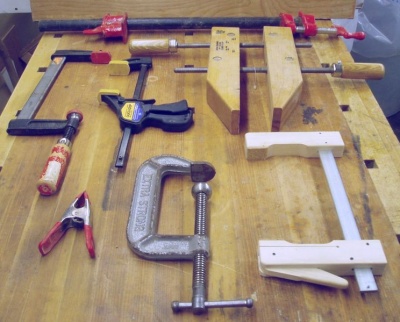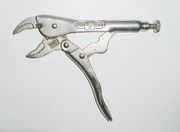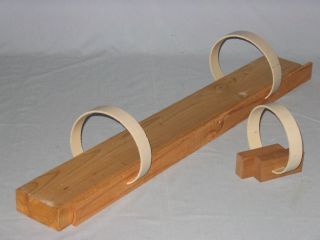Clamp
G clamp
Also known as a C clamp or G cramp, this is a traditional clamp with high clamp force and numerous uses. The long screw thread tends to make it slow in use, so quick release clamps are preferred where their lower clamp force is sufficient.
G clamps are prone to denting the workpiece, due to high force on a small pad, or scratching workpieces. Loose load spreading pieces of wood, plastic, etc are used to avoid this, but make handling the assembly less easy.
Spring clamp
Very low clamping force compared to traditional clamps. Very quick to use. Can be useful for holding things in place while fixing them, but often several clamps are needed to give enough holding force.
Its possible to make basic spring clamps by cutting plastic pipe into C shaped pieces. See Make Things from PVC Pipe.
Sash Cramp
A sash cramp or sash clamp is a long bar clamp for larger pieces of woodwork. Widely used for gluing wooden goods.
Quick release clamp
These have a trigger mechanism to tighten the clamp, and a button to release grip. These find a lot of use in DIY due to fast easy use. The clamping forces don't compare to screw operated clamps, so they're not suitable for all tasks. Use of several quick release clamps improves total clamp force.
Spreader
Monkey wrench
Vice
The main advantage of a vice is its attached to a heavy bench, so it stops things moving. Vice jaws can damage workpiece surfaces. Wood, plastic or aluminium liners can help stop this.
Mole grips
A locking type of plier. Gives the highest clamping force of any portable type of clamp.
Portable workbench
Portable workbenches are used in place of a bench & vice. Their performance is not comparable, but they will still do a lot of jobs. These are mainly used for portability, and where there is not enough space to have a proper bench. Accessories are easily made to enable clamping of non-flat items.
Heavy Object
Gravity is enough for some jobs.
Rope & Wedge
A rope is tied round the items to be clamped. Wedges are inserted under the rope to pull the rope tight. Using one wedge on each side avoids asymmetric pull.
When a wedge is not to hand, scrap wood, food tins and so on can be used.
The advantages are:
- enables jobs to be done when no proper clamps are to hand.
- it can secure oddly shaped workpieces
- it can clamp any size of workpiece
The disadvantages are:
- there is not good accurate control of clamping tension
- wedging on one side only will pull items out of alignment, so access to both sides is needed for reasonable performance.
- maximum clamping force is limited, though often sufficient to get the job done.
Dog Clamp
A dog clamp is a piece of sheet metal with 2 spikes that are knocked into the pieces of wood to be held together. Inserting the clamp pulls the wood together.
These are used when minor damage to the end of the workpiece is acceptable.
|\ /| | \ / | | \________/ | | | |______________|
PVC Pipe Clamp
A PVC pipe clamp is nothing more than an inch of pvc pipe slit open. It is a simple type of spring clamp readily made from plastic pipe scrap. If you need greater clamping force, use 2" pieces of pipe instead of 1".
The clamp on the right has fancy wooden jaws added. This increases the spring force by pushing the pipe further out, but reduces maximum throat size.
http://www.pvcworkshop.com/ShopProjects.htm
Tape
Tape can be used as a crude clamp. The tape is puled tight as its applied, and clamping force builds up with each added turn of tape. An initial layer of paper or polythene can be used to stop tape sticking to the workpiece.
Screw
A screw in an inconspicuous position is sometimes good as a clamp.
Clothes Peg
Simple minimal cost spring pegs. Small jaw opening, too small and too weak for most work. Oversize pegs are now available. For very small workpieces a whole row of pegs can give enough clamping force to do the job.
Not a good DIY tool, but on hand in most homes.
Vacuum Press
A vacuum clothes storage bag is connected to a hoover for light clamping, with the workpiece inside. Force is exerted on the workpiece in all directions. There is very little access to the workpiece when inside the bag. Almost never used for DIY, but it has been done.


